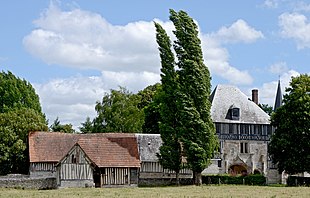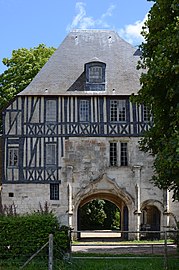Manoir de Marbeuf
The Manoir de Marbeuf is a manor house in the northern French municipality of Sahurs, about 15 kilometers southwest of Rouen in Normandy . It was built by Louis de Brézé in the first quarter of the 16th century in the flamboyant style. A little later he added a Gothic chapel to the complex .
The manoir is now privately owned and cannot be visited, but it is clearly visible from the street. Parts of it have been under monument protection since May 7, 1945 as a classified Monument historique ( French Monument historique classé ) .
history
The Seneschal of Normandy Louis de Brézé and his wife Diana of Poitiers often hunted in the forest of Roumare, a large wooded area north of Sahurs , in the 16th century . Around 1515, Louis de Brézé built a hunting lodge in Sahurs, where he could stop off with the hunting parties. A few years later he added a small chapel to the complex.
The poet Pierre de Marbeuf was one of the subsequent owners of the manoir . He had the system revised and in 1637 received the approval from Pope Urban VIII to consecrate the chapel of Our Lady of Peace ( French Notre-Dame de la Paix ). The Pope also granted various indulgences , and the chapel became a destination for pilgrimages . It is said that the French Queen Anna of Austria also visited the chapel as a pilgrim and asked for peace for France and an heir to the throne in a prayer. When her requests were heard, in 1638, after the birth of her son Ludwig , she donated a statue of the Madonna made of solid silver to the small church of God , which weighed the weight of the newborn: 24 marks , i.e. almost 5.9 kilograms. She was brought to Sahurs in a solemn procession . At that time there was a proverb "It was Sahurs who gave France a king." ( French C'est Sahurs qui donne un Roi à la France. ) The statue was part of the chapel decoration until the French Revolution , but on the 15th frimaire of the year II (December 5, 1793), the owner of the manor at the time gave the Madonna to a representative of the Mint in Rouen to have it melted down.
description
The Manoir de Marbeuf stands on the right bank of the Seine on the edge of the Boucles de la Seine Normande Regional Nature Park . It consists of several buildings, of which only the massive gate and the chapel from the first complex from the 16th century. A large stone in front of the street-side facade of the chapel bears the coat of arms of France. Pierre the Marbeuf received it at the behest of King Louis XIII. , and it indicated that the property was exempt from billeting of royal troops.
A special architectural feature is a barn belonging to the complex . The wooden structure is one of the few examples in the area called Boucle de Roumare that is perched on stilts .
The three-story gateway has a ground floor made of Caumont stone, while its upper floors are made of timber framework , the supporting timbers of which are clad with slate on the outside . The building is closed off by a shingled hipped roof. The arched gate passage is crowned by a multi-curved, sculpted keel arch . To the right of it is a much smaller hatch . The keystone of the flat ribbed vault of the passage shows the coat of arms of the Brézé family, while the east facade of the gateway building on the courtyard side has medallions with the heads of Pierre de Marbeuf and his wife. To the north are two single-storey half-timbered buildings from the 18th century, one behind the other, with a base made of Caumont stone.
On the south side of the gateway is the Gothic chapel Notre-Dame de la Paix with a five- eighth closure and external support pillars . The church building is completed by a slate roof. It has a narrow roof turret with a tall, slate-covered helmet and a bell that was cast in 1829. In the 17th century, the chapel had a louis-treize- style porthole on the eastern side of the chapel , but this is no longer preserved today. The interior is illuminated by pointed arched windows with tracery in the style of the flamboyant. The wall sections under the windows are clad with Renaissance paneling . It comes from the same era as the bench seats. The three-bay choir has a ribbed vault, the keystones of which have coats of arms. Above the entrance is a gallery that was previously reserved for the gentlemen of the country estate. The mobile equipment of the chapel includes several paintings from the 17th and 18th centuries as well as a Madonna and a statue of St. John from the 17th century.
literature
- Noël Broëlec: La Normandie. Châteaux et Demeures. Minerva, Geneva 1995, ISBN 2-83-070306-6 , p. 9.
- Sophie-Dorothée Delesalle, Christian Olles, Muriel Vandeventer (eds.): Le Patrimoine des Communes de la Seine-Maritime. Volume 2. Flohic, Paris 1997, ISBN 2-84234-017-5 , p. 754.
- Hervé Eveno: Histoire dʼun Manoir "Renaissance" à Sahurs… 2 volumes. Self-published, Sahurs 2015.
- Philippe Seydoux: Châteaux du Pays de Caux et du Pays de Bray. 2nd Edition. Éditions de la Morande, Paris 1987, ISBN 2-902091-17-6 , p. 111.
Web links
- Entry of the facility in the Base Mérimée of the French Ministry of Culture (French)
- Information on the Notre-Dame de la Paix chapel on rouen.catholique.fr (French)
References and comments
- ↑ Entry of the annex in the Base Mérimée of the French Ministry of Culture (French), accessed on October 24, 2019.
- ^ A b c d e Sophie-Dorothée Delesalle, Christian Olles, Muriel Vandeventer (eds.): Le Patrimoine des Communes de la Seine-Maritime. Volume 2, 1997, p. 754.
- ↑ The literature gives different information on the year of construction, they fluctuate between (around) 1520 and 1525.
- ↑ The Manoir de Marbeuf on chateau-fort-manoir-chateau.eu , accessed on October 24, 2019.
- ↑ a b c d e f Information on the Notre-Dame de la Paix chapel on rouen.catholique.fr , accessed on October 24, 2019.
- ^ Philippe Seydoux: Châteaux du Pays de Caux et du Pays de Bray. 1987, p. 111.
- ↑ Presentation of the chapel on patrimoine-religieux.fr , accessed on October 26, 2019.
Coordinates: 49 ° 21 '24.1 " N , 0 ° 56' 40.5" E


